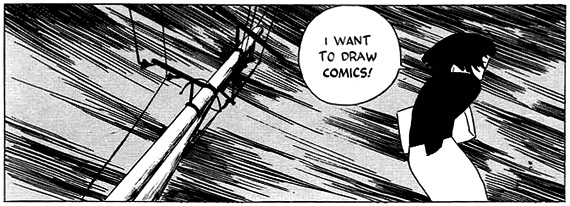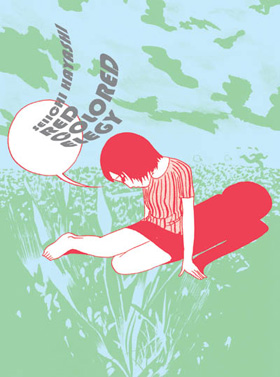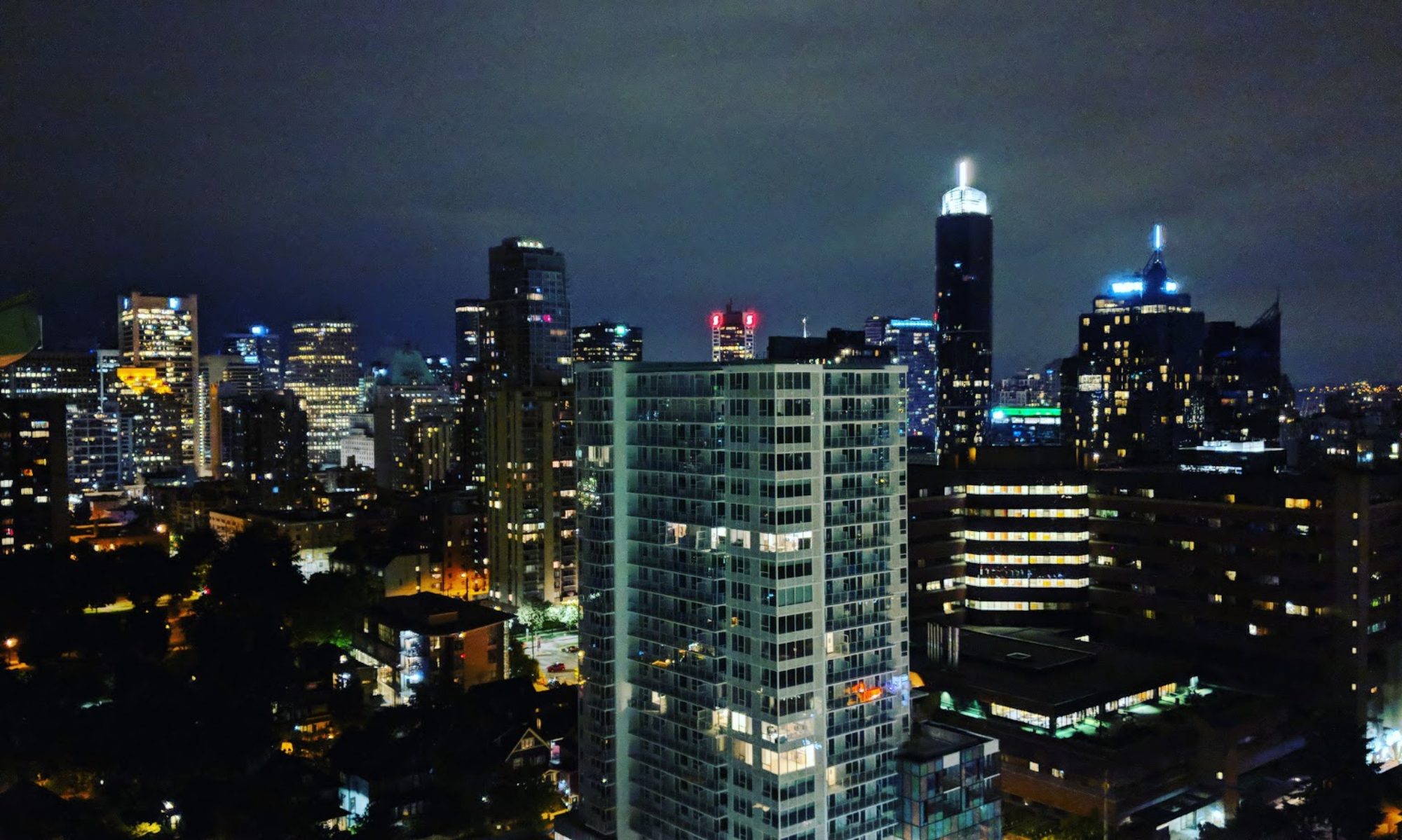
 I haven’t linked to Adam Stephanides site Completely Futile for a while, but his recent post on D+Q’s manga initiative made me think, so I wanted to respond. Here, I’ll let Adam explain his problems with D+Q’s manga releases in his own words:
I haven’t linked to Adam Stephanides site Completely Futile for a while, but his recent post on D+Q’s manga initiative made me think, so I wanted to respond. Here, I’ll let Adam explain his problems with D+Q’s manga releases in his own words:
Drawn & Quarterly’s edition of Red Colored Elegy, a Japanese-language edition of which I reviewed here, is finally out. (Note that the D&Q book contains only the title story from the edition I reviewed, not the shorter stories that were also collected there.) Unfortunately, I can’t greet this occaion with unalloyed joy, because Drawn & Quarterly did the same thing that they did with their Yoshihiro Tatsumi collections: rearranging the panels on each page so that the page (and the book) reads left-to-right, but not flipping the original panels.* Why do they do this? If they aren’t going to publish it unflipped, which they should, I’d much prefer that they just flipped everything. That way the relationships between the panels, and the overall design of each double-page spread, would be preserved. I really don’t understand. Drawn & Quarterly is clearly publishing this as a labor of love, so why do they deliberately mutilate it? – Adam Stephanides, Completely Futile blog
I really enjoyed reading Red Colored Elegy in the D+Q edition, and if you enjoy a work that challenges you as a reader I’d recommended it. That said, I am bothered by the ideology of the D+Q release, of selectively flipping panels or cut-and-pasting pages. I even advocated against such back in the day, back when I heard the first Tatsumi Yoshihiro book The Push Man and other stories was on its way. But despite my problems with this method of formatting manga for North American release, as onerious as this production method is, a) it has the approval of the actual author of the work, and b) every other method for translating manga into English is potentially worse.
I don’t like flipped manga because mirror-imaging original art tends to reveal imperfections in drawing, that’s just the way it goes. It also makes manga-ka practically die of embarassment, seeing work with all of its flaws revealed to the world. I also think that, should someone like D+Q release a manga unflipped, the commercial possibilities of the work are practically halved. Any time a prominent blogger talks about a new manga release, Ed Brubaker (love ya Ed!) pops up in the comments to mention that he can’t read unflipped [backwards] manga. Just can’t read it. And he’s not alone… it’s one of the things that makes unflipped manga so attractive to younger readers by the way… it’s like visual pig-latin. So yeah, I mean, we get the Tatsumi books rearranged (“translated”) for Western audiences and the sales are great because the older, not-necessarily-manga-reading crowd that the books are aimed at can actually read them, and most importantly the original creator of the work is happy with it. Or, at the worst, he is at least happy enough (though having met Mr. Tatsumi, I can in fact confirm he is extremely proud of the D+Q editions of his work).
So, yeah, Adam, I really empathize with you on this one, because I’d love to read the work in a format as close to the original as possible. But I can’t, because I don’t read Japanese, and I’d rather the books come out and find a measure of success to ensure that more come down the pipe as well. And it’s not like D+Q doesn’t do a good job–they just don’t do the job we’d like them to do… a crucial difference.
On that note, Tom Devlin dropped in on Completely Futile to explain D+Q’s position:
Officially, we do this to reach as wide an audience as possible. We don’t view these books as specialty fiction but as stories that everyone should read. We realize that many people will view this as “mutilation” but we always run the English version past the artist before publication. In fact, Tatsumi actually rearranges the panels himself. I personally think of this approach to editing as somewhat similar to putting subtitles on a foreign film–it clearly alters the experience but it’s often the only way for many of us to experience the storytelling art of different cultures. – Tom Devlin, D+Q, on the Completely Futile blog
I think it’s just a matter of fingers crossed, waiting for the industry to change at this point. But it’ll be… shit, 10 years minimum before the readership base comfortable with reading unflipped manga is large enough to support niche or artcomix releases. Keep hope alive, Adam!
– Christopher


I’m attempting to learn to read unflipped manga with Cat-Eyed Boy, but so far, still a struggle.
Maybe it’s hubris, but I’m happy to say that in my capacity of editor for Tokyo Zombie I decided to do without the HEY! YOU”RE READING BACKWARDZ page in the “front” of the book. Not sure if we’re shooting ourselves in the foot there, but I want to start heading to the other side of the door, and point to the humdrum (in a good way) familiarity of reading manga. At least, among our expected audience.
If you want to come see it, we’ll have copies on hand at the Last Gasp booth at SDCC. I’m working the booth Friday 2-7pm, if you wanna stop by and say hello 🙂
KEEP HOPE ALIVE!
Ryan
Ed- Cool beans. 🙂
Ryan- I think it’s worth exploring the work as an object, and a foreign object at that, and I think this is a really interesting book to test that with. It’s very fashionable in a similar–though more Japanese and adult–way than a lot of contemporary manga available in English. I’m really excited about the book, it’s one that I’m really looking forward to in SD and I’ll make sure to come by the booth during that time!
I have no problem reading backwards (even being in my upper 30’s), but I also see no problem with the D+Q solution. A good compromise I think.
The same thing (moving panels) was done with Blade of the Immortal wasn’t it? I remember the flow in the book being terrible. Now admitedly that’s a comic with sword fights, so maybe having panels reading right to left on a page that’s going left to right is more important. But yeah, I’d rather have stuff like that flipped.
Reading Ed’s comment made me realize that reading that way was difficult at first, but it’s second-nature now. I can barely read left to right comics, so this is a good sign.
Yes, Blade of the Immortal was (and is) cut-and-pasted, at Hiroaki Samura’s request. This results in some oddities, because some sequences can’t be cut-and-pasted without making them incomprehensible, so they’re flipped… which means that Manji’s missing eye constantly switches around from right to left. But you get used to it.
I’d love to see an unflipped BotI — Dark Horse started publishing the series in 1997, before unflipped manga became commonplace, and I guess they’ve stuck with the cut-and-paste technique so as not to alienate the existing readers who are used to reading BotI left-to-right.
(Incidentally, to see the difference it makes, this is a discussion of how Samura constructs his action scenes using the Dark Horse cut-and-pasted edition, and this is a follow-up in which the panels have been rearranged to be in their original order. As the writer demonstrates, the visual flow of the scene is much smoother in the original.)
The main problem I have with reading unflipped manga is one nobody ever seems to mention – while it’s not that terrible a stretch to get used to reading the images right to left, English still reads left to right. So with the words and images pushing in opposite directions, the flow of panels will never really be smooth, never really be what the artist intended. Something’s always going to be lost in translation.
For me, I’d much rather just read a flipped book. Having never seen the original unflipped pages, the imperfections revealed in their mirror images will probably go largely unnoticed. It’s worth suffering the occasional accidentally flawed image for the comfort of reading left to right, and for words and images flowing in the same direction. That said, if a book looks interesting enough, I’ll certainly suffer the awkwardness of reading it unflipped, as I likely will with those Black Jack and Dororo books…
Chris, can you point out a specific panel or page that is flipped where you, a reader, can see specific imperfections in the art where it is unflipped?
I understand why artists don’t like to see their art flipped, as holding a mirror up to a piece has long been a way for an artist to get a fresh view. But I’m not sure I buy it from a reader’s perspective.
In reading tranlated manga and attempting to read manga with the little that remains of my once fourth grade level Japanese, flipping, rearranging and direction of reading seem to not be the biggest issue when it comes to translation. Either way, flipped or unflipped, one can get pretty close to the original reading experience of absorbing pictures and words.
The dialogue in any translation from Japanese, be it subtitles in a film or word balloons in a Manga are what most often feel like half measures. I can’t say in most cases that I can propose better alternatives, but anyone with a passing familiarity with Japanese language and culture knows that people in Japan don’t say the same things to one another that they would in west. The back and forth of idiomatic politeness, the nuance of relationship between characters conveyed in the conjugation of a verb – direct translations of these always seem stilted, but converting the text to what westerners would say in the same situation strips the scenes of much of their meaning. In a story that consists mostly of swordplay, or magical toys, I’m sure that the flipped images are a bigger deal, but in things that I would want to read, having a good translator is what is important, and here I think D&Q has done as good a job as anyone in the field.
Red Colored Elegy ends up being one of my favourite manga because it remains challenging to the reader and open to much interpretation. Hayashi says so much with so little — entire scenes in an image or two, single lines of dialogue from an unspecified speaker – I can imagine how difficult this was to translate.
Crap! I was hoping that Tokyo Zombie would be flipped.
Sorry Tom 🙂 TZ is being presented in all its unflipped glory. I still hope you’ll give it a chance though!
I love Hanakuma and can’t wait to get the book at SD. It’s my first stop for sure. His work is at the top of my personal manga short-list.
Katherine: I honestly never noticed BOTI’s cut-and-paste nature, but seeing the comparison really does make it stand out. It would be nice if Darkhorse started releasing unflipped omnibus of the series, but on the other hand I do like current high-quality books and it would be a tough to get used to a smaller/cheaper format.
As for the issue at hand, I generally don’t base my purchases on the format of the manga. Flipped, unflipped, cut-and-paste, as long as I’m interested in it I’ll buy it. Of course I would prefer if to be all in the original format and I can’t really understand why some people find right-to-left so hard to read, but as long as the format means RCE (which is excellent by the way) will sell as many copies as possible then I’m for it.
Jamie – Sound effects in untranslated manga, when positioned horizontally or diagonally, are drawn to be read left-to-right.
Jamie — I couldn’t agree more. This is one of the impediments to reading manga for me. In my local comic shop I jokingly claim that unflipped books are some clandestine form of cultural imperialism on the part of the Japanese. The reality is that I simply find it too laborious to read manga that way. Give me flipped books any day. I thank D&Q for not automatically alienating me as an audience by publishing the book unflipped.
Here’s a point I never see raised: Are Japanese audiences required to read translated western (English, French, etc) comics from left-to-right. I’m betting that they flip those books for the Japaense audience. In the end I think the non-flipping policy is far less about aesthetic purity than expediency and cost cutting.
Bah!
I began a contribution as site for exclusive use of naruto. Please link to this site if I do not trouble you. I intend to publish a related story of naruto serially steadily from now on. Please cheer it.